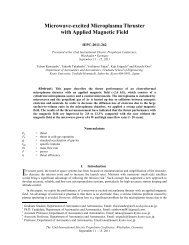Development of a Magnesium and Zinc Hall-effect Thruster
Development of a Magnesium and Zinc Hall-effect Thruster
Development of a Magnesium and Zinc Hall-effect Thruster
Create successful ePaper yourself
Turn your PDF publications into a flip-book with our unique Google optimized e-Paper software.
A retarding potential analyzer (RPA) was used to determine the ion energy during each thruster experiment.<br />
The probe that was implemented was a four-grid RPA, as shown in the schematic <strong>of</strong> Fig. 8.<br />
Ion<br />
Collector<br />
Secondary<br />
Electron<br />
Repeller<br />
Ion<br />
Repeller<br />
Electron<br />
Repeller<br />
Fig. 8. Four-gridded retarding potential analyzer showing the grid locations.<br />
The first grid in the RPA, at the probe entrance, was electrically floating. The second grid was biased<br />
negatively with respect to plasma potential to ensure that only ions are allowed to enter the probe. The third grid is<br />
the ion repeller. The grid was biased from 0 to 300 V with respect to ground to filter the ions that can enter the<br />
probe. As the grid potential is increased, only ions with a sufficient amount <strong>of</strong> energy can pass through. The fourth<br />
grid is biased with a negative potential to prevent any secondary electrons from escaping from the collector when it<br />
is struck with the high energy ions. Typical RPA probe current vs. repeller voltage sweeps <strong>and</strong> the derivatives <strong>of</strong> the<br />
sweeps during magnesium thruster operation are shown in Fig. 9 <strong>and</strong> Fig. 10. The RPA was placed 1 m downstream<br />
<strong>of</strong> the thruster on the thruster axis when recording data. Despite an uncertain value <strong>of</strong> magnetic field <strong>and</strong> open-loop<br />
operation <strong>of</strong> the thruster, the RPA data show reasonable acceleration <strong>of</strong> the propellant ions.<br />
Fig. 9. Retarding potential analyzer I-V sweep <strong>and</strong> derivative <strong>of</strong> probe<br />
current with respect to repeller voltage with 190 V <strong>and</strong> 4 A on the<br />
anode <strong>and</strong> 4 A <strong>of</strong> magnet current during magnesium operation.<br />
The 31 st 8<br />
International Electric Propulsion Conference, University <strong>of</strong> Michigan, USA<br />
September 20 – 24, 2009<br />
Entry<br />
Grid






